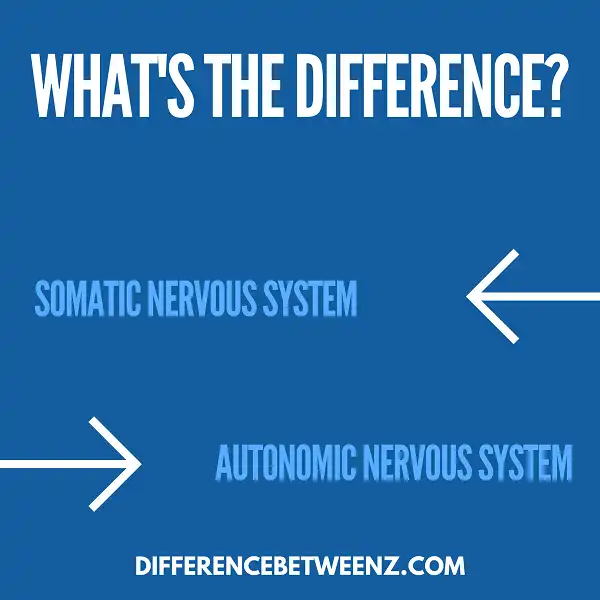The autonomic nervous system and the somatic nervous system are two different systems in the body. The autonomic nervous system controls all of the automatic functions of the body, such as heart rate and digestion. The somatic nervous system is responsible for voluntary muscle movement. In this blog post, we will discuss the difference between these two systems in more detail. We will also explore how they work together to keep our bodies functioning properly. Stay tuned!
What is Somatic Nervous System?
The somatic nervous system is a subdivision of the peripheral nervous system that consists of voluntary efferent neurons that innervate skeletal muscles. Somatic motor neurons are multipolar neurons with their cell bodies in the spinal cord or brainstem. When they reach the target tissue, they synapse directly on the muscle fibers without an intermediate relay neuron.
- Somatic motor neurons are thus considered direct pathway motor neurons. The axons of somatic motor neurons are myelinated by oligodendrocytes in the CNS and by Schwann cells in the PNS. Somatic sensory neurons have their cell bodies in the dorsal root ganglia or cranial nerve ganglia and innervate skin, skeletal muscles, and joints.
- They convey information about touch, pressure, temperature, pain, and proprioception (muscle stretch) to the CNS. Somatic sensory neurons are bipolar neurons with their dendrites in the target tissue and their cell bodies in the dorsal root ganglia or cranial nerve ganglia. Their axons synapse on second-order neurons in the dorsal horn or trigeminal nucleus of the gray matter of the spinal cord or brainstem, respectively.
- Somatic sensory receptors are located in the skin, skeletal muscles, and joints and are activated by touch, pressure, temperature, pain, and muscle stretch. The activated receptors generate action potentials that travel along the axons of peripheral somatic sensory neurons to synaptic terminals in the dorsal horn or trigeminal nucleus of the central nervous system (CNS).
What is Autonomic Nervous System?
The Autonomic Nervous System (ANS) is the part of the nervous system that controls involuntary functions of the body, such as heart rate, digestion, and respiration. The ANS is divided into two parts: the sympathetic nervous system and the parasympathetic nervous system.
- The sympathetic nervous system is responsible for the “fight-or-flight” response, which prepares the body for a stressful event. The parasympathetic nervous system is responsible for the “rest-and-digest” response, which slows down the heart rate and promotes relaxation.
- Autonomic dysfunction occurs when there is a problem with the way the Autonomic Nervous System functions. Symptoms of autonomic dysfunction include lightheadedness, fainting, fatigue, and difficulty regulating body temperature.
- Autonomic testing can be used to diagnose autonomic dysfunction. Treatment options include lifestyle changes, medication, and surgery.
Difference between Somatic and Autonomic Nervous System
The Somatic Nervous System is responsible for the voluntary control of skeletal muscles, while the Autonomic Nervous System controls the involuntary action of smooth muscles, cardiac muscles, and glands. The main difference between Somatic and Autonomic Nervous System is that Somatic Nervous System has direct control over skeletal muscles whereas Autonomic Nervous System has indirect control over all types of muscles.
- The Somatic Nervous System consists of motor neurons that directly or indirectly control the contraction of skeletal muscles. Its main function is to provide communication between voluntary commands from the brain to the body muscles. The Somatic Nervous System can be further divided into two subsystems, namely, the extrinsic subsystem and the intrinsic subsystem.
- The extrinsic subsystem includes nerves that originate from the central nervous system and terminate in skeletal muscles. The intrinsic subsystem, on the other hand, includes nerves that originate and terminate within the same region of the central nervous system.
- The autonomic nervous system, on the other hand, is responsible for controlling all involuntary actions of smooth muscle, cardiac muscle as well as glands. Just like Somatic Nervous System, Autonomic Nervous System can also be divided into two parts – the sympathetic division and the parasympathetic division.
- The sympathetic division is responsible for preparing the body for a ‘fight or flight’ response during stressful situations, while the parasympathetic division counteracts the sympathetic division by promoting a ‘rest and digest’ response.
To sum it up, Somatic Nervous System is responsible for the voluntary control of skeletal muscle whereas Autonomic Nervous System controls all involuntary actions in smooth muscle, cardiac muscle, and glands. Another key difference between Somatic and Autonomic Nervous systems is that the Somatic Nervous system has a direct connection with skeletal muscle whereas Autonomic Nervous System has an indirect connection with all types of muscles via ganglion neurons.
Conclusion
As you can see, there is a big difference between the somatic and autonomic nervous systems. The autonomic system controls all of the unconscious actions in our body while the somatic system controls all of the conscious actions. Knowing how these two systems work can help you understand why your customer is behaving a certain way and how to appeal to their needs.


